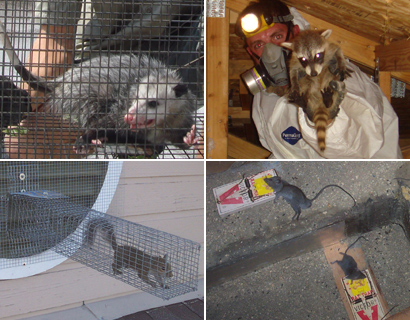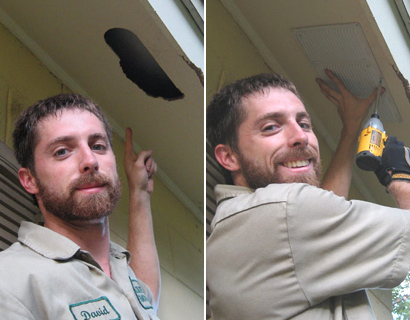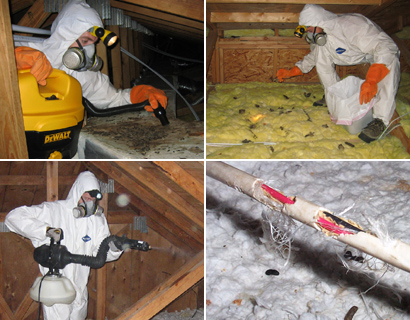- How We Solve Wildlife Problems
How We Solve Wildlife Problems
INSPECTION: Once on site, we will perform a full inspection. If the problem involves wildlife inside your house or attic, we need to inspect the entire building. We look for any possible entry hole, and any and all signs of animal activity, such as chewing, fur/grease, footprints, etc. We carefully check the following:
- All ground-level areas, such as piper or A/C line entry & exit areas, A/C chase bottoms, ground-level vents, etc.
- All mid-level areas, such as dryer vents, siding gaps, first floor eaves or dormers, etc.
- The eaves (and soffits) are very important to inspect carefully, because they are one of the most common areas of entry.
- We inspect the entire roof, including all plumbing stacks, ridge caps, vents, and other potential gaps or holes.
- We also inspect inside your attic, which is very important in determining what species of animal you have, numbers of animals, the damage they have caused, etc.
TRAPPING, EXCLUSION, REMOVAL: Once we understand exactly what animal species we are dealing with, and the numbers, we use the most effective means of removing the animals. We use dozens of different types of traps and devices appropriate to each situation. Our knowledge of animal behavior, time of year, architecture of building, number of animals, and many other factors determine our approach.
- Trapping - In some cases, this means trapping the animal(s) in the appropriate traps. We often mount special traps directly on animal entry/exit holes.
- Exclusion - Oftentimes, we are able to simply set one-way doors or other exclusion devices that allow the animals inside a building to safely exit, but never get back inside.
- Removal By Hand - Sometimes we actually remove animals by hand, or with special tools like snare poles. We transfer them to carriers and take them away.
- The Law - In all cases, we obey state and local laws regarding wildlife, and always aim to take the most humane approach and relocate wildlife alive.
ENTRY HOLE REPAIRS: Repairs are a crucial step in the wildlife removal process. In all cases, sealing the entry holes shut ensures that no future wildlife will ever enter your home. If you've had wildlife once, this proves that your house is desirable to local wildlife, and the previous animals may leave a scent behind that new animals will follow. Repairs keep future animals out. But more importantly, entry hole repairs are absolutely necessary during the process of removing several wildlife species. For example, rats usually have many entry holes into a house. It is futile to attempt trapping them until all the entry holes are sealed FIRST. And what if you want to install a one-way exclusion device for squirrels, bats, or other animals? All secondary possible points of entry must be sealed shut first, in order for this technique to work.
- 100% of the entry holes must be found, and sealed shut, or the job is not complete.
- Our repairs are professional contractor grade, and we use steel, which rodents such as rats or squirrels are unable to chew through.
- We give a written guarantee on our repairs against any future animal entry.
ATTIC DECONTAMINATION & OTHER SERVICES: In some situations, it may be desirable to clean your attic after you've removed animals from the space. They can leave behind large amounts of droppings, urine, hair, oils, food, nesting material, and so on. These remnants can attract insects like cockroaches, and the scent left behind can encourage new animals to attempt to chew or break their way into your house. You might also experience odor problems from the waste. It's possible or likely that mold will grow on the areas of feces and urine, and urine can damage wood or sheetrock. Some of the mold can potentially cause diseases that people can catch, and some of the feces themselves can cause diseases, such as Salmonella or Leptospirosis, and raccoon feces can contain roundworm eggs, which can infect people. It's also adviseable to repair any torn ductwork in an attic, along with any torn pipe insulation or chewed electrical wires.
- We remove or vacuum all droppings, or remove all the soiled insulation.
- We fog the attic with a special enzyme-based cleaner that destroys any organic matter and deodorizes the space.
- We repair damage, such as ductwork, electrical wires, pipes, insulation, and more.
Some how-to instruction guides:
How To Get Rid of Wild Animals
How To Get Rid of Armadillos
How To Get Rid of Bats
How To Get Rid of Bird
How To Get Rid of Dead Animals
How To Get Rid Of Groundhogs
How To Get Rid of Opossum
How To Get Rid of Raccoon
How To Get Rid of Rats
How To Get Rid of Skunk
How To Get Rid of Snakes
How To Get Rid of Squirrel





